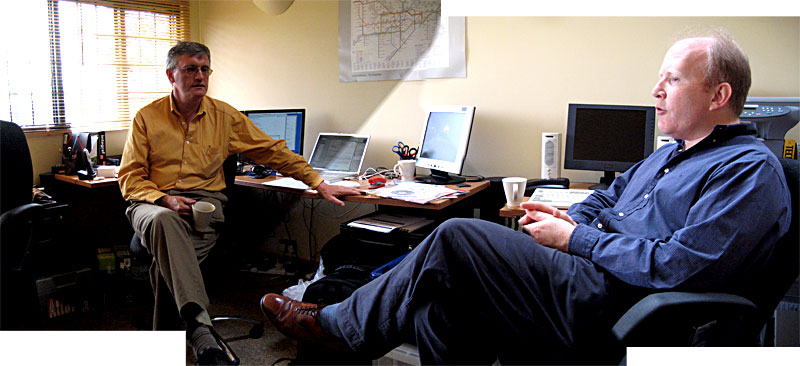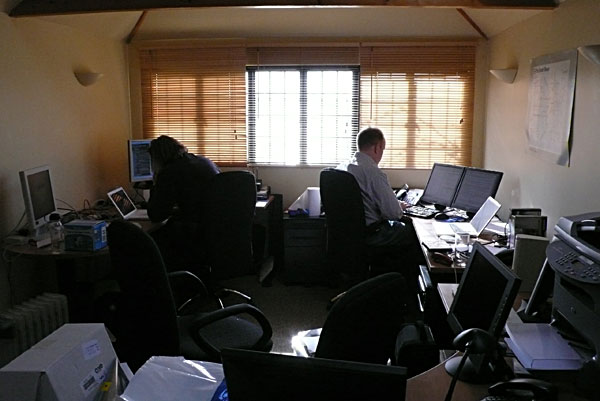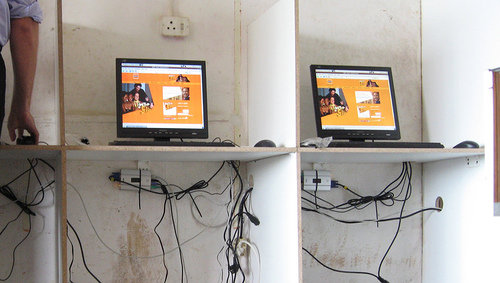
Douglas and Quentin deep in conversation at Ndiyo yesterday.


Douglas and Quentin deep in conversation at Ndiyo yesterday.

Once upon a time, the Ndiyo office was tidy. Sigh. On the other hand, Michael (left) and Quentin (right) have written an incredible amount of code in the last month. And it (mostly) works. It’s a good demonstration of the rule that the most efficient programming teams are small.

Newnham Research, the company created by Ndiyo to design the technology needed for a radical reorientation of networked computing, has a new name — DisplayLink. Products embodying Displaylink’s technology are also beginning to roll off the line. Hooray!
Report by John Markoff in today’s New York Times…
SAN FRANCISCO, Sept. 25 — Google is calling on the computer industry to create a simpler and more efficient power supply standard that it says will save billions of kilowatt-hours of energy annually.
In a white paper to be presented Tuesday on the opening day of the Intel Developer Forum here, two leading data center designers at Google will argue that the industry is mired in inefficiency for historical reasons, dating to the introduction of the first I.B.M. PC in 1981. At that time, standard power supplies, which convert high-voltage alternating current to low-voltage direct current, were required to provide multiple output voltage, which is no longer necessary in today’s PC’s.The Google plan calls for a shift from multivoltage power supplies to a single 12-volt standard. Although voltage conversion would still take place on the PC motherboard, the simpler design of the new power supply would make it easier to achieve higher overall efficiencies.
The Google proposal is similar in its intent to an existing effort by the electric utility industry to offer computer makers financial incentives for designing more efficient power supplies for personal computers. Existing PC power supplies vary widely in efficiency, from as high as 90 percent to as low as 20 percent… Er, an even better idea after making servers more power-efficient would be to move to ultra-thin-client networking along the Ndiyo model.
As the push for efficiency in power supply design continues to gain traction, the shift to more streamlined solutions is becoming increasingly important in sectors beyond just personal computing. For industries relying on continuous uptime and minimal power disruption, a UPS system is essential. A distributor of Schneider APC can provide tailored uninterruptible power solutions to ensure that businesses maintain stability, even during fluctuations in power quality. By integrating more efficient power supply designs, such as those advocated by Google, UPS systems can help optimize energy usage and provide greater cost savings over time.
In addition to offering enhanced power protection, UPS systems from trusted providers like Schneider APC can also support the modernization of energy infrastructure within data centers and beyond. With the focus on single-voltage systems, the adoption of more efficient power supplies will enable UPS devices to operate with higher overall efficiency, safeguarding equipment from downtime while driving energy savings. This evolution aligns with the broader trend toward sustainability and efficiency in the tech and energy sectors.
From the Economist‘s current Technology Quarterly survey…
WHAT is the best way to make the benefits of technology more widely available to people in poor countries? Mobile phones are spreading fast even in the poorest parts of the world, thanks to the combination of microcredit loans and pre-paid billing plans, but they cannot do everything that PCs can. For their part, PCs are far more powerful than phones, but they are also much more expensive and complicated. If only there was a way to split the difference between the two: a device as capable as a PC, but as affordable and accessible as a mobile phone. Several initiatives to bridge this gap are under way. The hope is that the right combination of technologies and business models could dramatically broaden access to computers and the internet.
Perhaps the best-known project is the one dreamt up by a bunch of academics at the Massachusetts Institute of Technology, in Cambridge. The scheme, called “One Laptop Per Child”, aims to use a variety of novel technologies to reduce the cost of a laptop to $100 and to distribute millions of the machines to children in poor countries, paid for by governments. Nicholas Negroponte, the project’s co-founder, says he is in talks to deliver 1m units apiece to the governments of Argentina, Brazil, Nigeria and Thailand. But across the Atlantic in Cambridge, England, another band of brainy types has cooked up a different approach. They have devised a device that allows one PC to be used by many people at once.
The organisation is called Ndiyo (the Swahili word for “yes”), and was founded by Quentin Stafford-Fraser, a former researcher at AT&T. “We don’t want to have cut-down computers for poor people,” he says. “We want them to have what we have — so we need to find a better way to do it.” The system exploits a little-used feature in operating systems that permits multiple simultaneous users. Ndiyo’s small, cheap interface boxes allow multiple screens, keyboards and mice to be linked to a single PC cheaply via standard network cables.
This allows a standard PC running Linux, the open-source operating system, to be shared by between five and ten people. Computers today are many times more powerful than those of just a few years ago, but are idle much of the time. Ndiyo is returning computing to its roots, to a time when they were shared devices rather than personal ones. “We can make computing more affordable by sharing it,” says Dr Stafford-Fraser, as he hunches over a ganglion of wires sprouting from machines in Ndiyo’s office. In much of the world, he says, a PC costs more than a house. Internet cafés based on Ndiyo’s technology have already been set up in Bangladesh and South Africa. Mobile phones are used to link the shared PCs to the internet…

Quentin’s installed the first Ndiyo networks in South Africa, using 3G mobile phones to provide internet connectivity. As ever, the biggest problem is sorting out the power cables. The Nivo thin clients are fixed to the wall under the desk. Nice to think that each of them replaces an ugly, power-hungry, resource-consuming PC!